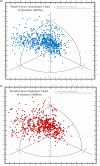Nutritional status, body indices, and somatotype in Aymara and Quechua children from high Andean areas of Peru
- PMID: 40838265
- PMCID: PMC12361683
- DOI: 10.1017/jns.2025.10026
Nutritional status, body indices, and somatotype in Aymara and Quechua children from high Andean areas of Peru
Abstract
Infants born at high altitudes, such as in the Puno region, typically exhibit higher birthweights than those born at low altitudes; however, the influence of ethnicity on childhood anthropometric patterns in high-altitude settings remains poorly understood. This study aimed to characterise the nutritional status, body composition and indices, and somatotype of Quechua and Aymara children aged 6-10 years. A cross-sectional, descriptive, and comparative design was employed, with a simple random sampling of children from six provinces representative of the Puno region, including 1,289 children of both sexes. Twenty-nine anthropometric measurements were taken, and fat, muscle, and bone components were assessed using bioelectrical impedance analysis. Standardised equations were applied to determine body indices. Among the findings, most children presented normal nutritional status according to BMI-for-age and height-for-age Z-scores. However, high rates of overweight and obesity were observed in Aymara (39%) and Quechua (28.4%) children, with differences in fat content between ethnic groups at the 5th, 10th, 50th, and 75th percentiles. Both groups were characterised by brachytypy and brachybrachial proportions; Quechua children were mesoskelic and Aymara brachyskelic, with macrocormic proportions, rectangular trunks, and broad backs. The predominant somatotype was mesomorphic, with a stronger endomorphic tendency among Aymara. It is concluded that both groups exhibit normal nutritional status; however, Aymara children show a greater tendency towards fat accumulation and notable morphological differences. Differences were also observed in limb proportions, particularly a relatively shorter lower limb.
Keywords: % BF, body fat percentage; % BM, bone mass percentage; % MM, muscular mass percentage; AII, acromio–iliac index; BI, brachial index; BII, biiliocrestal iliac index; BM, bone mass; BMI, body mass index; BS, bone structure; Body composition; Body indices; CI, cormic index; EPAS, endothelial PAS domain-containing protein; Ec, ectomorph; En, endomorph; FM, fat mass; HIF, hypoxia inducible factor; High altitude; IP, ponderal index; ISAK, International Society for the Advancement of Kinanthropometry; MM, muscle mass; Me, mesomorph; P, percentile; R, resistance; RBI, relative biacromial index; RLLE, relative length of lower extremities; RLUE, relative length of upper extremities; SD, standard deviation; SI, schelic index; Somatotype; V, volume; VM, visceral mass; WHI, waist–hip index; WHO, World Health Organization; WHeI, waist–height index; Z-score, standard score; p, resistivity.
© The Author(s) 2025.
Conflict of interest statement
Each author declares that he/she has no conflicts of interest, financial or otherwise.
Figures




Similar articles
-
Diagnostic performance of anthropometric measurements for identifying obesity in high-altitude pediatric populations: evidence from tibet via bioelectrical impedance analysis.Lipids Health Dis. 2025 Jun 19;24(1):216. doi: 10.1186/s12944-025-02623-5. Lipids Health Dis. 2025. PMID: 40537784 Free PMC article.
-
Prescription of Controlled Substances: Benefits and Risks.2025 Jul 6. In: StatPearls [Internet]. Treasure Island (FL): StatPearls Publishing; 2025 Jan–. 2025 Jul 6. In: StatPearls [Internet]. Treasure Island (FL): StatPearls Publishing; 2025 Jan–. PMID: 30726003 Free Books & Documents.
-
Normal-weight obesity in high-altitude youth: Gender disparities and protective effects of native adaptation.PLoS One. 2025 Aug 1;20(8):e0328992. doi: 10.1371/journal.pone.0328992. eCollection 2025. PLoS One. 2025. PMID: 40748963 Free PMC article.
-
[Somatotyping according to the Heath-Carter scheme - the relationship between body type and gender, age and level of physical activity].Vopr Pitan. 2025;94(2):18-37. doi: 10.33029/0042-8833-2025-94-2-18-37. Epub 2025 Mar 25. Vopr Pitan. 2025. PMID: 40418132 Review. Russian.
-
Nutritional interventions for survivors of childhood cancer.Cochrane Database Syst Rev. 2016 Aug 22;2016(8):CD009678. doi: 10.1002/14651858.CD009678.pub2. Cochrane Database Syst Rev. 2016. PMID: 27545902 Free PMC article.
References
-
- Hartinger S, Tapia V, Carrillo C, et al. Birth weight at high altitudes in Peru. Int J Gynaecol Obstet. 2006;93(3):275–281. - PubMed
-
- Rupert JL, Hochachka PW. The evidence for hereditary factors contributing to high altitude adaptation in Andean natives: a review. High Alt Med Biol. 2001;2(2):235–256. - PubMed
MeSH terms
LinkOut - more resources
Full Text Sources
Research Materials
Miscellaneous

